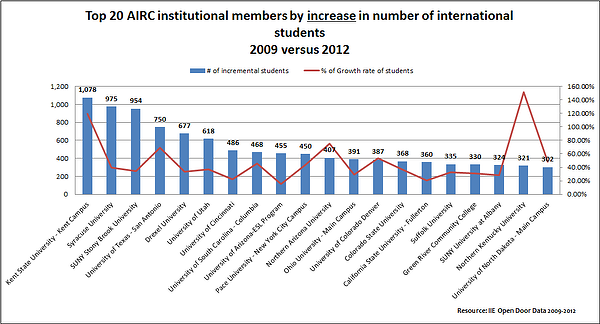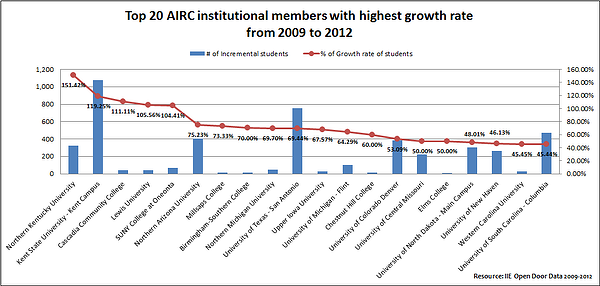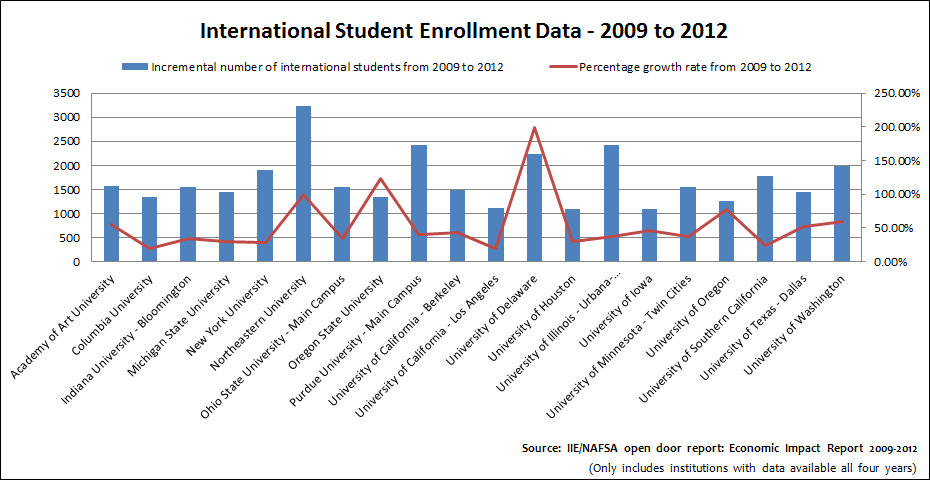During the past couple of weeks we have analyzed international student data for trends showing us which universities have been successful with their international student recruitment activities. See Consider the Competition (Insight 4/10/13) and the blogs onOhio and Massachusetts. One of our readers suggested that we compare trends between universities using independent international recruiting agencies and those using only internal resources for their international enrollment efforts.
First of all, WE LOVE READER FEEDBACK! Let us know what you are thinking about or struggling with. If we can shed some light on how the industry is approaching your issues, we are happy to do it. Second of all, we loved the idea of this comparison, and so, we used the IIE Open Doors data from 2009 – 2012 and started analyzing.
There is no definitive list of universities using commission-based recruiters. And the diversity of our universities and the internal nature of the recruiting process make it difficult for us to know exactly what recruiting channels universities use to attract students. In contrast to Australia, few universities in the U.S. publicly display their list of international agents used. So we resorted to using the AIRC - the American International Recruitment Council - membership list representing 172 institutional members. We could identify the four-year data set for 107 members, which included universities and ESL programs. AIRC is the organization setting standards for the use of recruiting agents and encourages active management of recruiting agency networks.
While we are familiar with many of the institutions that are AIRC members and know that they officially or informally use agents, we do not know the percentage of students recruited using agency-based recruiting services and whether each university has signed agreements with recruiting agents. We should also note that agencies may get compensated via commissions, marketing fees or other business arrangements. So the enrollment figures we are able to analyze do not tell us how many students came from each recruiting channel. That said, there are some interesting trends we can identify.
We were interested in the following questions:
- What's the track record for AIRC members over the past years?
- How well do AIRC universities recruit additional international students using agencies as part of their recruiting methods compared to the broader group of U.S. institutions?
- What's the overlap between AIRC members and the highly successful institutions analyzed from the Open Doors report as a whole?
- Does agency recruiting offer a specific segment of universities an avenue to grow international enrollment?
(Spoiler alert: the top 20 universities using agencies to attract international student populations differ dramatically from the top 20 universities we previously analyzed and the agency use group showed significantly higher growth rates in international student enrollment.)
We applied the same methodology we used for the entire IIE/NAFSA Open Doors report to the subgroup of AIRC members for which the data was available. Graph 1 (below) shows the institutions with the largest number of incremental international students enrolled during the past four years (left scale) as well as the percentage increase of those enrolled international students (right scale). We are comparing 2009 versus 2012. The total AIRC membership group's enrollment grew by 15.6 % vs. 13.8 % growth for the entire Open Doors report's list.
Maybe these results are not that surprising, given that AIRC members show a particular interest in international student recruitment by joining the organization. More interesting is the comparison of the Top 20 universities in the Open Doors report and among the AIRC members.
As we mentioned, these two groups we compared have distinct differences. There is no overlap in the group of these 20 universities we identified from the total Open Doors university group and the AIRC members we identified from Open Doors as the most "successful international recruiters." And while both groups of 20 are pursuing their international enrollment plans in distinct way, they are both finding success. Yet, the non-AIRC group includes highly branded institutions such as Columbia, NYU, Berkeley and others with global reputations (See Graph 3 below).
And from our analysis, one of our conclusions is that the top 20 AIRC group - a group with much lower global brand recognition as a whole - are assuccessful as the non-AIRC top 20 group in growing their international student enrollment.
While not conclusive, this trend suggests that using recruiting agencies offers an advantage to universities that do not benefit from highly recognized brands. It seems to make sense: if you have low advertising saturation and employ a broader sales force (agents), you can compete with those with larger advertising budgets (or brand presence).
For example, Green River College (fourth from the right in Graph 1) grew their international student body by 30% from 2009 to 2012 by adding 330 international students for a total of 1,407. A second example, Drexel University, successfully enrolled 677 more international student reaching a total of 2,684. With both of these, we are looking at universities with a large base of international students.
Graph 2 (below) shows the 20 universities with the highest growth rates of incremental international students. Notice that the highest growth rates tend to be correlated with a small base of previously enrolled international students, with a few notable exception of large public universities such as Kent State and Northern Arizona University.
Graph 1
Graph 2
AIRC is a relatively young organization and as mentioned, members are at various stages of their deployment of internationalization plans for their campuses. They are still building their international recruitment capabilities. We also noticed a number of AIRC member universities with steep declines in international student populations including University of North Alabama, Oklahoma City, University of Findlay and Bridgeport University. Here is a link to the total list and data available to us.
Bottom Line: International student enrollment represents a big opportunity, but the majority of universities in the U.S. currently lack both the scale and the brand recognition to make large leaps forward. As university leadership sets its sights on larger international student enrollment figures, realistic expectations and projections are critical. To succeed, universities will need to find and invest in smart and cost efficient ways to compete with the bigger players and highly branded universities. Professionally managed, thoughtful use of recruiting agencies seems to be one way to increase international student enrollment.
Graph 3 - Top 20 US Universities based on international enrollment




